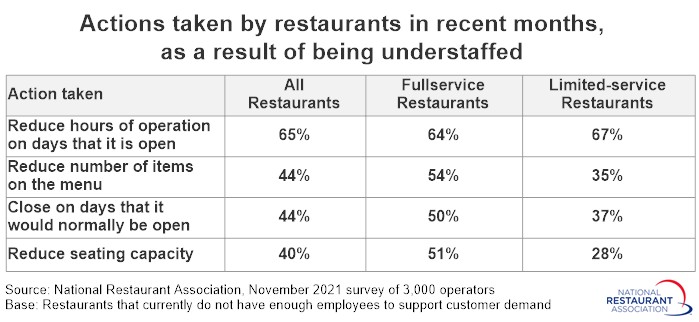Restaurant job growth remained sluggish in September
Restaurants continued to have difficulties boosting staffing levels in September, as job growth slowed significantly from recent months. Eating and drinking places* added a net 29,000 jobs in September on a seasonally-adjusted basis, according to preliminary data from the Bureau of Labor Statistics.
September’s modest gain followed a revised decline of 24,700 jobs in August, which means overall employment levels were essentially unchanged between July and September.
The last two months represented a sharp deceleration from the average monthly gains of nearly 200,000 jobs during the first seven months of 2021. As a result, eating and drinking places remained more than 900,000 jobs below pre-pandemic staffing levels.
Nearly 4 in 5 restaurants are understaffed
Although the industry added back many of the jobs lost during the early months of the pandemic, a majority of restaurants remain understaffed. In a September 2021 survey fielded by the Association, 78% of operators said their restaurant did not have enough employees to support existing customer demand.
A solid majority of both fullservice operators (81%) and limited-service operators (75%) said their restaurant did not have enough employees to meet customer demand in September.
For most restaurants, staffing was significantly below necessary levels. Among restaurants that were understaffed in September, 83% of operators said their restaurant was more than 10% below necessary staffing levels. Thirty-nine percent of understaffed operators were more than 20% below necessary staffing levels.
Thirty-seven percent of understaffed fullservice operators and 43% of understaffed limited-service operators said their restaurant was more than 20% below necessary staffing levels in September.
Open late or close early
As a result of being understaffed, 68% of operators say their restaurant reduced hours of operation on days that it is open for business. Forty-six percent of operators cut back on menu items, while 45% closed their restaurant on days that it would normally be open. Forty-four percent say they reduced seating capacity as a result of being understaffed.
These practices were much more common in the fullservice segment, with a majority of understaffed fullservice operators saying they took each of these four actions in recent months.

*Eating and drinking places are the primary component of the total restaurant and foodservice industry, which prior to the coronavirus outbreak employed 12 million out of the total restaurant and foodservice workforce of 15.6 million.
Read more analysis and commentary from the Association's chief economist Bruce Grindy.